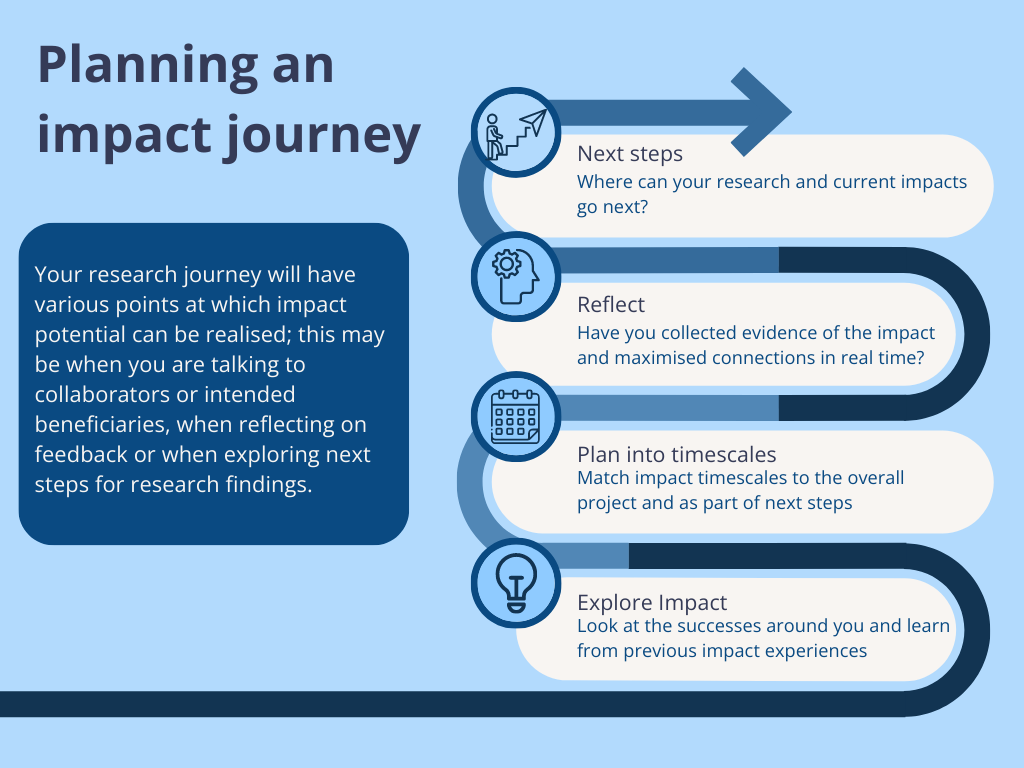
Adding impact to research planning and beyond
Impact is a growing aspect of academic life. As such, it is important to embed impact into your research planning as early and effectively as possible. By integrating impact into your research journey at the initial planning stages, it allows you to optimise evidence collection, collaboration opportunities and strengthening partnerships. Impact is synonymous with change, which can be maximised if it is part of project planning from inception.
There are a variety of questions to ask when planning work which has impact aspects. These questions should be considered at the planning stage but should be revisited as the project progresses. By asking these questions, you are embedding impact work more solidly into the project plan and, consequentially, will be better prepared to maximise it. Here are some examples of questions you may ask:
- What can/is likely to change?
- Who might it have impact on?
- How can the users or people/groups benefiting from the research be engaged by or in the work?
- What are the best ways/channels to reach them?
- How might they, the work and society benefit?
- How can the change be captured?
- Is there preliminary/benchmark information that needs to be collected to demonstrate the degree of change at a later date?
- What might be required from partners in terms of impact and evidence?
- Which aspects may evolve into next steps?
Reach and Significance
When planning impact work, it is important to have a clear idea of who or what you want to change. Once you have established the direction of your impact in this way, you can plan how to engage with the intended audience/user group. Through engagement, you will be able to establish a baseline of the size of your work’s potential influence, also known as its reach. Reach refers to how far your research transcends. Establishing the potential reach of a project allows you to hypothesise where it can go, and plan how to get there. It may be that your users are limited due to trait, demographics, or other criteria. In such cases it is good to identify and frame the total potential audience that can be reached.
Whilst reach is a valuable component of impact, it is maximised in conjunction with significance; the depth to which the changes from your research have permeated. Having meaningful, long-term engagement can be a marker of impact particularly for work aimed at improving public understanding where benefits can be demonstrated in part by sustained engagement with a target audience.
Impact capture
Reflecting on ways to be aware of the impacts of your work is a key stage in the planning process. A measurement of impact success can be established through strong impact capture mechanisms. These points can be at pivotal stages of the impact journey at which change escalates or takes a new direction. The more key points at which you can evidence the impact can make yout impact story stronger, but it is important to realise you don’t need to evidence ‘everything’.
It is important to gather evidence in a timely manner while information is fresh and enthusiasm is high; this may be determined by the project, partner and circumstances.
Nurture relationships and ensure there is clear understanding of what evidence you might require from partners, whether in the form of testimonials or regular updates.
Collect any benchmark information you may need in future to contextualise or compare the degree of change.
Some methods of capturing quantitative evidence may be through longitudinal data-points, or via using multiple methods simultaneously.
Consider examples of impact types and indicators of change as well as the others’ impact journeys.
Learning user needs; feedback and co-creation
Working with your intended beneficiaries, whether industrial partners, patients, governments or the wider public, allows impact work to relate more inclusively to need/demand. Strong impact projects do not work with a knowledge deficit model, they plan in collaboration with who/what they aim to change. It is important to plan in this aspect of impact work, as it allows for alteration to happen during project work, increasing its potential by learning from others and understanding their needs. For advise on how to more fully engage with your users/partners see our resource on Audience Communication.

